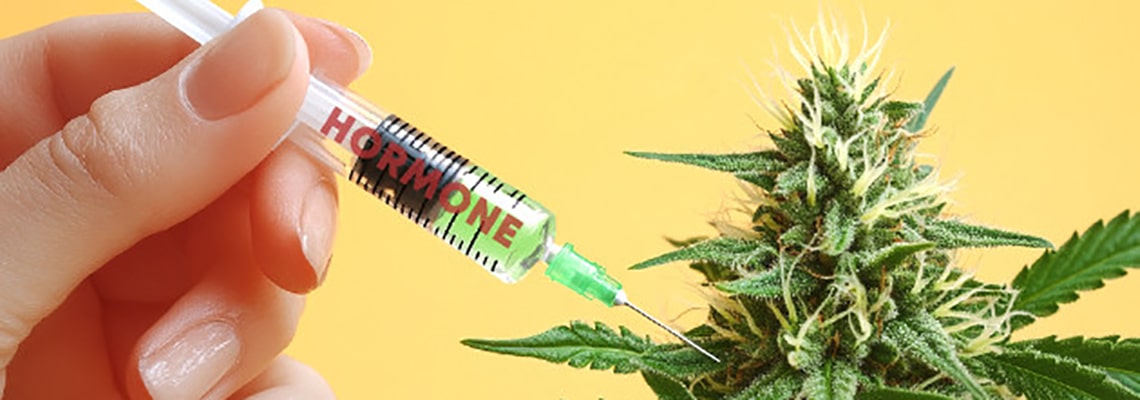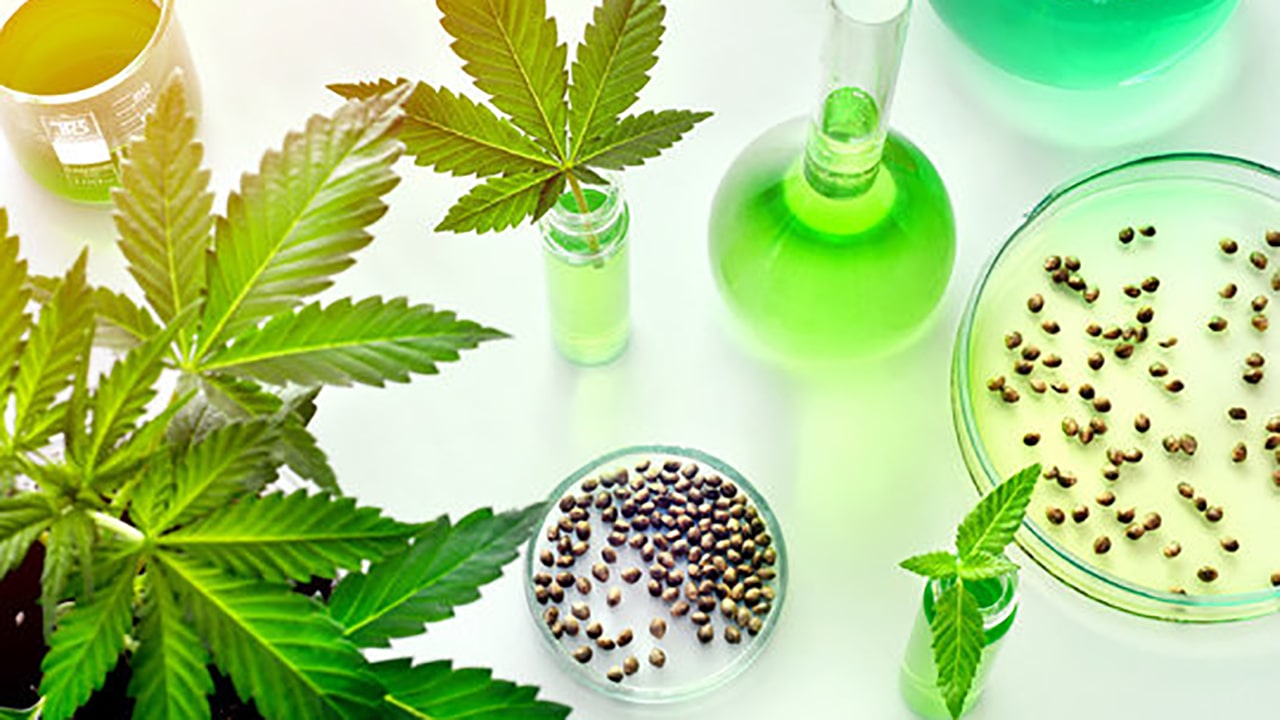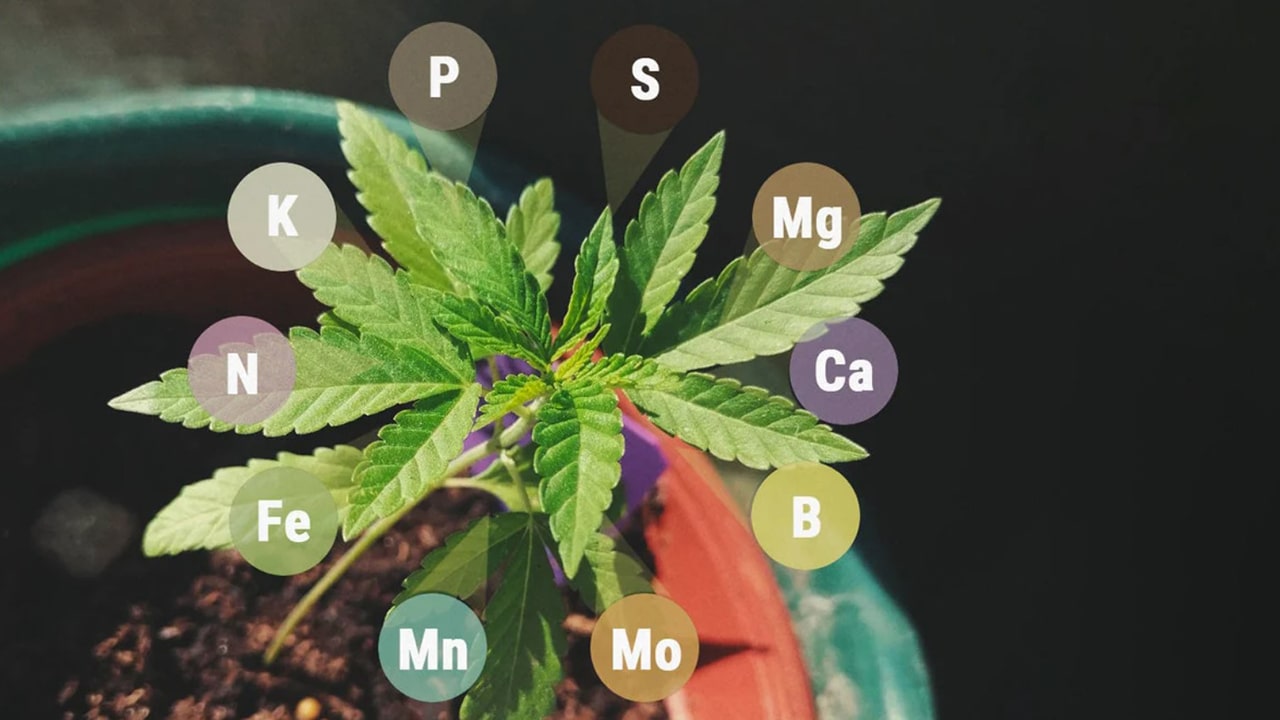There seems to be nothing in your cart.
Didn't find what you were looking for? Contact our consultant.
To save your shopping cart until your next visit, create an account or register .
Browse our Hits sales
There seems to be nothing in your cart.
Didn't find what you were looking for? Contact our consultant.
To save your shopping cart until your next visit, create an account or register .
Browse our Hits sales

Content
Cannabis plants, like any other plants, contain a group of hormones called phytohormones. These chemical compounds regulate all processes of growth and development, from seed germination to maturation and flowering.
Auxins are hormones that promote cell elongation and stimulate root system growth. They play an important role in the initial stages of bush development. When cannabis seeds germinate, auxins are distributed throughout the plant and stimulate parts of the plant to grow towards light sources, which is especially important for sativa varieties, which are known for their tall stature. In addition, auxins promote the development of a strong root system, which is important when using various fertilizers, as the roots need to absorb nutrients efficiently.
Cytokinins are responsible for stimulating cell division, which promotes branching and increased foliage mass. In cannabis, this is especially important for creating a dense plant with lots of flower inflorescences. In indica varieties, which tend to be more compact compared to sativa, cytokinins help to form dense bushes with many branches, which increases yields. In addition, cytokinins promote the development of lateral shoots, making the bush more productive and resilient.
Gibberellins control stem elongation and overall increase in size. They are particularly active in sativa, where stems can grow to considerable heights. Gibberellins also play an important role in the flowering process by stimulating the plant's transition from the vegetative stage to the flowering stage. In autoflowers, gibberellins help to rapidly transition into the flowering phase without the need to change the light regime, making such varieties extremely suitable for growing under limited conditions.
Abscisic acid is a hormone that is responsible for regulating dormancy. It helps cannabis to cope with stress, regulates water balance and closes the eyelids on the leaves in conditions of drought or lack of water. This hormone is also involved in the fruit ripening process and prevents premature flowering, which is especially important when growing feminized cannabis species where control over the developmental phases of the plant is required.
Ethylene is a phytohormone that regulates the ripening and aging process. It helps to shed leaves and flowers when they are no longer needed and is also involved in the ripening process of cannabis buds. Ethylene is especially important during the end of flowering, when the herringbone begins to concentrate its resources on maturing inflorescences.
The use of fertilizers can significantly affect the levels of phytohormones in cannabis plants. For example, nitrogen promotes vigorous growth through increased production of auxins and cytokinins. However, excess fertilizer can upset the hormonal balance, leading to undesirable effects such as stem elongation or delayed flowering. That's why it's important to maintain a balance of nutrients for optimal growth and development of cannabis, whether it's autoflowering or feminized variants.
Cannabis hormones play a key role in its life cycle and their activity can be regulated with the right cultivation approach to achieve the desired results and high yields.

Cannabis sativa and indica varieties differ significantly not only in their external characteristics, but also in their growth and development patterns, which are regulated by different phytohormones. These hormones have a key influence on bush growth, morphology, flowering and adaptation to the environment. It is important to realize that each cannabis variety is unique and its development is directly dependent on the interaction of various hormones such as auxins, cytokinins, gibberellins and others.
Sativas are cannabis plants that are known for their tall and slender growth, long flowering period and lighter leaf structure. These developmental characteristics of sativa are due to the increased activity of certain phytohormones, particularly gibberellins and auxins.
Sativa has high levels of gibberellins, which are responsible for stem elongation and cell elongation. These hormones stimulate active upward growth, which makes sativas tall and slender. Gibberellins also affect the speed at which the plant enters the flowering phase. Sativas have a slower start to flowering than indica because gibberellins continue to stimulate stem growth even while others are already starting to build up nutrients for flowering. In autoflowering sativa varieties, gibberellins play a key role in maintaining balanced growth even with minimal changes in light conditions.
Auxins help to form a strong root system and stimulate growth in the direction of light. In sativa varieties, the activity of auxins is especially important in the early stages when the herringbone is just beginning to develop. These hormones promote the development of long stems and strong roots, allowing the plant to absorb more nutrients.
Indica is a type of cannabis that are characterized by a more compact form, dense foliage and rapid flowering. These features are due to the dominance of other phytohormones such as cytokinins and abscisic acid.
Cytokinins are active in indica varieties, which stimulate cell division and promote the formation of thick, dense bushes with many branches. Cytokinins are especially important for indica, as they help to develop side shoots and increase the area for flowering. This makes the plant more compact but still remains extremely productive. In feminized indica Christmas trees, cytokinins control the development of the flower inflorescences, ensuring uniform and rapid flowering. This makes indica an excellent choice for those who want a quick and abundant harvest.
Abscisic acid in indica plays an important role in controlling dormancy and regulating flowering processes. It prevents premature flowering, which is especially important when using grooving methods with growboxes or in environments where control of light cycles is required. In addition, abscisic acid promotes adaptation to stressful conditions, which is particularly useful when cultivated in unfavorable environments. Indica, due to the effect of abscisic acid, has a faster and more stable flowering than sativa, which speeds up the entire cultivation process.
For sativa and indica varieties, fertilizer use can affect hormone balance in different ways. For example, higher levels of phosphorus and potassium in fertilizers stimulate the activity of auxins and cytokinins, which can accelerate plant growth and development. However, it is important to maintain a balance, as excessive use of fertilizers can disrupt the hormonal system and reduce crop quality. In autoflowering and feminized cannabis varieties, proper nutrition is especially important to maintain stable growth and flowering.

Autoflowering and feminized types of cannabis differ from traditional varieties in their unique genetics and growth behavior. These varieties are created specifically to facilitate grooving and increase yields, and phytohormones play a key role in their development.
Autoflowering variants of cannabis are unique in that their flowering is not dependent on changes in the light cycle. This is due to the genetics of ruderalis, a wild subspecies of cannabis that develops in harsh climates with short summers. Phytohormones play an important role in regulating the growth and flowering of autoflowering types, as these plants automatically start flowering at a certain time after planting, regardless of the length of the daylight cycle.
In autoflowering cannabis types, gibberellins and ethylene have the greatest impact. Gibberellins stimulate stem elongation and the transition from the vegetative stage to the flowering stage. Since autoflowering varieties start flowering without a change in light regime, gibberellins ensure a rapid change in growth phases.
Ethylene, the hormone responsible for the senescence and maturation process, also plays an important role in autoflowering varieties. It regulates the rate of inflorescence maturation and accelerates the completion of flowering. This is especially useful for autoflowering types, in which flowering must occur quickly and efficiently.
Abscisic acid in autoflowering types helps cannabis cope with environmental changes. It regulates dormancy, helps control water balance, and protects shrubs from stresses such as drought or excess moisture. This hormone also prevents premature flowering, which is important for autoflowering plants that need to remain in the vegetative stage for a sufficient amount of time to accumulate resources.
Feminized variants of cannabis are grown to produce exclusively female plants that produce maximum yields in the form of buds. In these varieties, the flowering process is regulated by the length of daylight hours, but hormones also play a key role in maintaining a stable and uniform development.
In feminized types of cannabis, auxins and cytokinins are important in regulating vegetative growth and preparation for flowering. Auxins promote active root growth and stimulate height growth, which is important in early development. Cytokinins, in turn, help develop lateral shoots and increase the area for inflorescence formation.
In feminized varieties, maintaining the correct levels of these hormones is especially important to ensure that the plant grows evenly and enters the flowering phase at the right time. The optimal combination of auxins and cytokinins allows feminized species to reach peak performance and produce high yields.
Unlike autoflowering varieties, feminized plants start flowering only when daylight hours are shortened, which is actively controlled by gibberellin levels. Gibberellins stimulate cell elongation and the transition from the vegetative phase to the flowering phase. However, it is important to monitor their levels, as excessive gibberellin concentrations can lead to excessive stem elongation, which is undesirable for feminized varieties as it can reduce cone density.
Fertilizer application for autoflowering and feminized types must be carefully balanced so as not to disturb the hormonal balance of the plants. In autoflowering varieties, which have a limited growing season, it is important to use fertilizers with a high nitrogen content in the early stages to stimulate active growth. Fertilizers with higher phosphorus and potassium content are added during the flowering period to enhance gibberellin and ethylene activity, accelerating cone maturation.
For feminized species, it is important to support all phases of growth. In the early stages, nitrogen fertilizers help enhance the action of auxins, supporting stem and root growth. When flowering begins, increased phosphorus and potassium fertilizers stimulate inflorescence development by activating cytokinins and gibberellins to promote uniform and abundant flowering.

Caution! Errors Seeds does not encourage you to grow cannabis and does not contribute to this in any way. Growing is prohibited by Ukrainian law. The article is of purely scientific and informational interest.